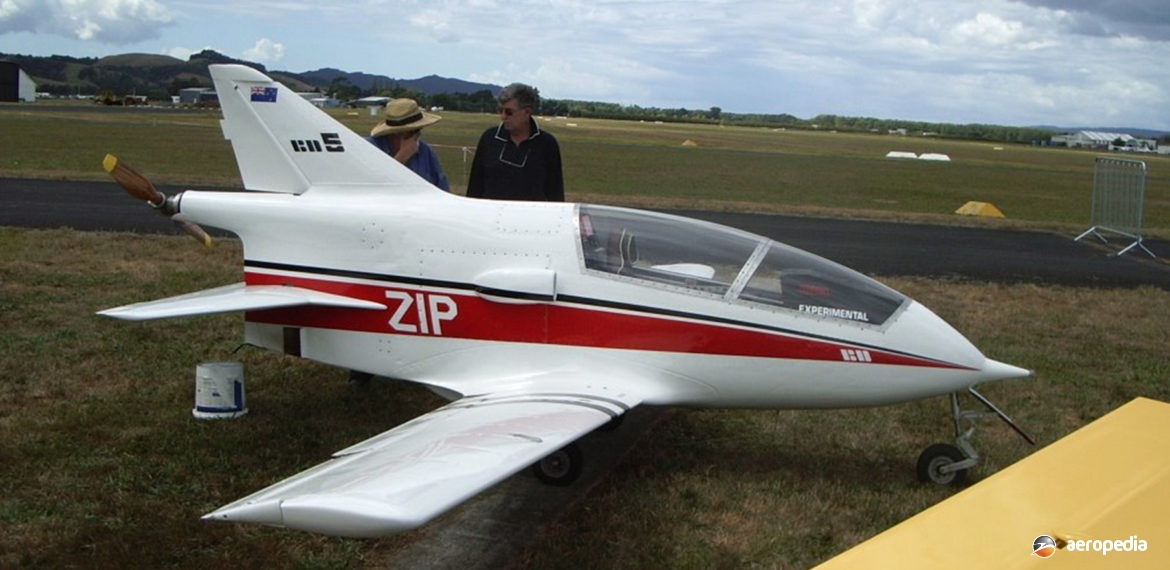Photograph:
Bede BD-5 VH ZIP at Serpentine, WA in 2012 (David Eyre – WA Avition)
Country of origin:
United States of America
Description:
Single-seat high-performance sport aircraft
Power Plant:
One 51 kw (68 hp) Hirth 2706 two-cylinder in-line air-cooled engine
Specifications:
- Wingspan: 6.55 m (21 ft 5 in)
- Length: 4.26 m (14 ft)
- Height: 1.7 m (5 ft 6 in)
- Wing area: 4.40 m² (47.36 sq ft)
- Max speed at sea level: 321 km/h (200 mph)
- Cruising speed: 290 km/h (180 mph)
- Max rate of climb: 579 m/min (1,900 ft/min)
- Stalling speed: 95 km/h (59 mph)
- Range: 1,159 km (720 miles)
- Empty weight: 209 kg (460 lb)
- Loaded weight: 376 kg (830 lb)
History:
The Bede BD-5 was one of a number of designs produced during the 1960s by Bede Aircraft of Newton, Kansas, USA to meet the requirements of the home constructor. Designed as a high-performance single-seater to limits of +6G and –6G, the BD-5 has had its share of problems over the years, most relating to the lack of a suitable engine. Design commenced in February 1967, the prototype, known as the BD-5A, flying for the first time on 12 September 1971 powered by a 30 kw (40 hp) Kiekhaefer Aeromarine two-cylinder engine. This aircraft had a wingspan of 4.37 m (14 ft 4 in).
Subsequently a variety of versions appeared. The BD-5B had an increased span and, after some extensive flight testing, the ‘butterfly’ or V-tail unit first fitted was replaced by a conventional fin and rudder, with an all-moving ’stabilator’. At this time the fibreglass construction was changed to all-aluminium and engine was the 41 kw (55 hp) Hirth unit of 650 cc. However, soon after Hirth went into liquidation and the engine became unavailable.
The BD-5B was then marketed with the 52 kw (70 hp) Xenoah engine and, although a number of kits were sold, very few were completed. BD Micro Technologies of Siletz, Oregon, USA was then formed to assist those who had received BD-5 projects. This company commenced production of up-dated kits and provided assistance to builders.
A variant also known as the BD-5B appeared later, this being a factory finished model; followed by the un-powered BD-5S glider and the BD-5G with a new wing section and a 52 kw (70 hp) Xenoah three-cylinder two-stroke engine. The BD-5J was also marketed, originally this model being fitted with a 202 lbst Microturbo TRS18 turbojet providing a max speed of 444 km/h (276 mph). By late 1971 Bede claimed it had 4,300 orders for the BD-5 series.
A number of kits were purchased by homebuilders in Australasia and some 32 are known to have been imported to New Zealand alone in the 1970s. However, due to engine and certification problems, none flew officially until 1985. ZK-XBD was built by Mr C A McMillan of Mosgiel, was registered on 3 June 2004 and was the first to fly in New Zealand. New Zealand Aerospace built a small number and two of these, ZK-DVE (a BD-5D – c/n 3886) and ZK-ZIP (c/n AACA/235), were fitted with a 41 kw (55 hp) Hirth engine. Now that other suitable engines have become available, others are expected to fly in the future.
Registrations allotted in New Zealand have included ZK-DYL (c/n 3902); ZK-DYM (c/n 3903); ZK-DYN (c/ n 3904) which later became ZK-XBD; ZK-DYO (c/n 3913AACA-240); ZK-DYP (c/n 3882 – AACA231-1); ZK-TCH (c/n AACA685); ZK-DYT (c/n 3877); ZK-RMT, a BD-5B later exported (c/n 3902 –ex ZK-DYL ntu); ZK-RWF (c/n AACA-629); ZK-XBD (ex ZK-DYN ntu); ZK-ZBD (c/n 3898) fitted with a Honda Civic engine, and ZK-ZIP (c/n AACA/235 – ex ZK-DYM ntu), which commenced flight testing at Ardmore in 2006, was exported in May 2013. Few were ever completed, and only a couple have ever flown. In later times one complete aircraft, and parts of others, have been imported and placed in storage at Rangiora.
Engines available in recent years have included the four-cylinder in-line 80 kw (108 hp) alloy Nissan MA09ERT unit which was fitted to two aircraft in Australia in 2004, these being BD-5B Micros VH-IWG 4 (c/n 366) in Western Australia and VH-NZG (c/n 963) in the Northern Territory. The latter was damaged in an accident in 2007. These two aircraft had a cruising speed at 1,524 m (5,000 ft) of 306 km/h (190 mph) and a max speed of 380 km/h (236 mph). Other engines now available include units from Honda, Daihatsu, Suzuki, Brabus and Rotax, all producing around 60 kw (80 hp).
A BD-5 has been restored and placed on display at the RAAFA Aviation Heritage Museum at Bull Creek near Perth, WA. A BD-5B Micro was registered on 1 May 2012 in Wembley, WA as VH-UBD (c/n CC-BD5B-01). One almost complete variant was placed on display at Wings Over Illawarra at Albion Park, NSW in May 2019 but was not flown at that time.
The BD-5 was developed to the BD-7. The prototype of this model N7BD was built in the United States but is not known to have flown. It was similar to the BD-5 and was of all-metal construction and was a much larger aircraft with the rear pusher propeller A project to build a BD-7 was commenced by Mr B Phillips of Kingsgrove, NSW. An airfame number does not appear to have been allotted bu it did receive the registration VH-BDP.

